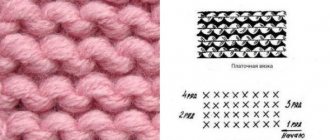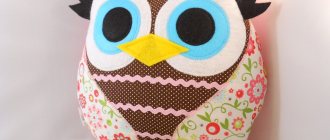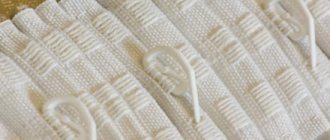In the modern world, it is impossible to imagine a cozy apartment without curtains covering the windows. They bring a special mood to the room, protect heat, protect from sunlight during the day and prying eyes in the evenings. Curtains give beauty, allowing you to hide some imperfections in walls, radiators or window frames.
Window decor serves as the finishing touch to the design of any room, without which the decor will not look harmonious.
But it happens that for various reasons (for example, when moving), you have to shorten the curtains because their length is no longer suitable for you. This article details some simple ways to shorten curtains without using scissors. Even a beginner with no sewing education can handle this job!
Many needlewomen undertake to sew it themselves, and when working, the logical question is: how to hem curtains?
How to shorten curtains without cutting them
Before starting work, ask yourself one most important question: “Do you need to shorten the curtains at all?” More often than not, the answer is positive – “yes”. This is understandable; no housewife would want a large amount of dust to accumulate in the lower part of her beautiful curtains, which is in contact with the floor, which stains the curtains and can cause severe allergies in small children. Another most popular question: “Why can’t you just cut the canvas with scissors? Why bother and come up with ways to shorten them without trimming?”
Before starting the sewing process, the purchased fabric should be decatted so that the finished curtains do not “shrink” when washed.
The answer is very simple. If you cut the fabric, the fabric will no longer be intact and there will be no way to return to the length that it was originally, but in the opposite case, this possibility remains, which is very convenient and profitable. In addition, after cutting with scissors, an unsightly edge remains, which can not only spoil the appearance, but also begin to crumble. Let's look at some options for shortening curtains without using scissors.
It is advisable to allow the curtain material to hang on the curtain rod for 2-3 days. Only after this can you start sewing curtains.
For all types of hemming and shortening curtains, there are several general rules.
- Select the thread exactly to match the fabric. On many materials, straight stitching will be almost invisible.
- For those materials that fray a lot, it is worth processing the edges before shortening. This is easy to do; sew the edges on a sewing machine using a zigzag stitch.
- Double hem fabric can be used for almost all occasions. But it is not suitable for hemming or shortening lined curtains.
- Hemming the fabric requires a mandatory basting. You can also do this manually. Make long stitches using additional pins.
- After basting the fabric, iron the hem as carefully as possible to avoid distortions and unnecessary folds.
To make the window curtain look beautiful and not form unnecessary horizontal folds, it is better to weight its bottom with weights.
Processing side cuts
If the side edges need processing, then it is better to do a double hem. The edge of the cut is bent by 1.5-2 cm and secured with a straight stitch or a hidden seam. Given the variety of materials, the bend size may vary, either increasing or decreasing.
The procedure was described earlier.
The difficulty of hemming along the grain thread lies in the possible stretching of the fabric. The layer underneath the fold tends to shrink and move when stitched. Therefore, while working, you need to monitor this and adjust the position of the layers in time, as well as slightly stretch the bottom sheet. Fixing the folds along the entire length with pins helps to simplify the work.
The sides can also be finished with edging.
How to hem curtains on a sewing machine, instructions, methods.
If you have a sewing machine at home, even a very ordinary one or a Soviet one, then you can perform any type of sewing work, and even a novice and inexperienced seamstress who does not have a specialized education as a seamstress can easily figure out how to carefully hem curtains on a sewing machine.
The treatment of seams largely depends on the density of the fabric and the use of lining.
This method is suitable for you if you suspect that the fabric will begin to crumble and crawl after washing. The difficulty with this method is that it requires frequent stitch spacing.
The method is very simple; it will be enough to know how to turn on the machine, insert the thread into the needle and pass the thread under the foot. Even if this information is new to you, you can look it up in the instructions or search the Internet.
Once you are sure that the machine is ready for use, proceed to shortening the curtains.
The algorithm of actions is as follows.
- Before starting work, take measurements of the required length. To do this, attach a measuring tape to the curtain and stretch it to the place where you would like the curtains to end. Then tuck the fabric to obtain the required length. Next we proceed to shortening.
- The length of the seam should be from 0.3 to 0.7 centimeters. This is the best option that will look as discreet and aesthetically pleasing as possible.
- There is no need to perform any processing or securing manipulations at the beginning and end of the line. Just tie the threads together and you're done!
It is better to hem simple thin curtains with a double hem.
Note! Some housewives advise overlocking the edges of the fabric before starting work, this will prevent the loss of nerve cells if the fabric suddenly begins to crumble.
Machine washing occurs in several simple steps:
Remove the curtains from the window. Remove the clips and rings from the curtains, soak separately in soapy water for 60-90 minutes, then rinse under running water and dry thoroughly. You need to wipe dry, especially metal parts, so that there are no streaks left on them.
Also pay attention to details made from other materials - after all, dust will settle on wet fasteners and they will quickly lose their appearance.
IMPORTANT! Before washing, test curtains for color fastness. To do this, dilute a little of the product you are going to wash with in water and drop it on the curtains
Wait a couple of minutes, then rinse off the product and let the curtains dry. If there are no traces left at the point of contact with the product, you can safely proceed to washing.
Load the curtains into the machine. Select a mode with a temperature of up to 40C and a spin speed of no more than 700 rpm (preferably less). Wash the curtains. Immediately after washing, return the curtains to the window so that they hang down - otherwise the fabric may wrinkle.
IMPORTANT! It is best to wash blackout curtains with liquid detergents, as they are more delicate to the fabric and color. IMPORTANT! Be sure to first wash the window and cornice, and only then hang the washed curtains - otherwise they will collect dirt and dust
Hem curtains with your own hands without a machine. Instructions
But not every housewife has a sewing machine at home, and this device is relatively expensive to buy it at once and only for the sake of shortening curtains, especially since this can be done manually and even in several ways!
For the easiest method, all you need is a needle, thread and a little sleight of hand.
- Before starting work, take all necessary measurements. Use a measuring tape, a piece of soap or chalk for this purpose. Then spread the fabric on the floor or other flat and hard surface.
- When all the necessary marks have been made, fold the edges of the curtain.
- Secure the resulting hem with needles or pins.
- Use thin needles that do not leave large holes.
- Take your time, hem as evenly and accurately as possible.
- At the beginning and end of the stitch, leave small ends of the thread, literally two or three centimeters.
After the work is completed, tie the ends of the threads tightly.
Method number 1. Classic method
Before processing the bottom of the curtain, measure and set aside its finished height (from the top loop on the curtain tape down to the desired length), and put a control mark (a pin or a chalk mark). Then, from the mark downwards, double the width of the hem is laid in its finished form. In other words, if the finished hem width for the bottom of the curtain should be 6 cm, set aside 6*2=12 cm.
In general, the finished tulle hem width varies from 5 to 6 cm, unless there are any reservations (for example, a different hem width at the request of the customer or designer) and the length of the fabric is sufficient.
Then all excess is cut off, and the allowance for finishing the bottom is ironed to the full width towards the wrong side. After this, the flying edge of the allowance is folded inward by half the width and ironed again.
Next, hem the bottom of the tulle, machine stitching along the edge of the seam allowance pressed inward. This method is called the Closed Hem Seam.
To avoid distortions in the process of hemming the bottom of the curtain, the allowance can be pinned to the tulle at certain intervals (20-30 cm).
The hemmed bottom of the curtain is ironed and, if necessary, pulled back a little.
A wide hem looks expensive and also acts as a weighting agent. Moreover, it can be released if there is a need to lengthen the curtain.
How to shorten tulle
It happens that the tulle also has to be shortened. This is especially true for kitchens, where it is customary to cover the windows with short curtains, and in houses with low ceilings. You don’t always want to cut the curtains, leaving ugly raw edges, but there is a way out! Curtains can always be shortened without trimming, just use your imagination, because this activity is quite creative and very interesting.
This section presents some secrets and recommendations on how to shorten curtains.
How to make it without cutting or hemming, the secret of housewives is how to make the required length.
There are times in life when you don’t have a machine, but you really, really don’t want to sew by hand. Don’t worry, housewives, there are several simple ways for you “for the lazy” that definitely won’t require additional costs or a lot of effort and time from you.
It is more convenient to carry out work on adjusting the bottom by hanging it, having first hung the curtain in the place intended for it.
For housewives who do not particularly want to form draperies and folds on the tulle, there is one very simple and effective way to shorten curtains. It is worth understanding that this method is only suitable for thin, flowing fabrics. This number will not work with thick curtains. It is worth warning that this method is very extravagant and is not suitable for every interior.
Best used in children's and playrooms.
The algorithm of actions is as follows:
- Place the tulle on the curtain rod and leave it overnight or for a day so that the fabric takes the desired shape.
- Thread a thick thread made of wool or nylon into a gypsy needle with a wide eye, preferably so that it differs minimally from the color of the curtain.
- Using a thread, roll the tulle into a medium-density roll, starting from the middle of the fabric, smoothly approaching the edges.
- Secure the resulting tulle roll with threads tied into knots. They can be any color.
But here is an option that is universal and will suit any interior - shortening curtains using curtain magnets.
They are relatively inexpensive and allow you to shorten the length of the tulle without hemming or trimming. There is a large selection of magnets for curtains on sale; they can be in the form of butterflies, animals, flowers, or they can be ordinary and almost invisible. But housewives who decide to use this method may encounter a problem. Some magnets may be too weak to hold the curtains. So be careful and always check magnets before purchasing. This will save you from unnecessary expenses.
They are very easy to use: pick up the edges of the tulle with magnets and pin them in several places.
As a result, you will get beautiful and unusual draperies and folds.
If you couldn’t find magnets for curtains in your city, then use bobby pins, crabs, pins and needles instead. But be careful, they can easily damage the fabric or prick you.
On sale you will find a large selection of magnets, both almost invisible, which will not stand out and attract attention, as well as bright and original.
Using adhesive tape and iron
One of the simplest, and most importantly fastest, ways to shorten curtains is with adhesive tape. It is also called cobweb.
In addition to the curtains themselves, the “gossamer” adhesive tape and the iron, you will also need two pins or needles, a sheet of A4 paper, an ironing board and a damp foam sponge.
Remember that the curtain must hang on the curtain rod overnight, or better yet, for a day, in order to obtain the desired shape.
Take a fabric that best matches the density of the curtains. A piece of 20 by 20 centimeters will be enough. This is necessary in order to make sure that the cobweb sticks and not inadvertently ruin the curtains. When you are sure that the web has completely dried and stuck, sharply tug the edges of the fabric.
If the adhesive tape has peeled off in some places, use several layers of it.
Now let's start shortening the curtains.
- Make sure the fabric is dry and straighten it out. Place duct tape between fold layers. Use pins to secure the folds for convenience.
- To glue the web to the tulle, iron it through a piece of paper for about forty seconds.
- Heat the edges of the seams twice as long.
If you buy a low-quality web, it may come off after a few washes, remember this when choosing a manufacturer.
Important! There should be no water in the iron!
How to hem organza correctly
Before sewing an organza curtain, you should trim the cut edges, because the fabric is very finicky and can fray at the edges. This can be done on a sewing machine using an overlock or zigzag seam at the maximum pitch. Also, after processing the edges, if necessary, sew on curtain braid in order to hang the organza on the cornice.
This is necessary so that the fabric, after hanging for one or two days on the cornice, acquires the desired shape.
If the organza has weights along the bottom edge, then it should be hemmed from the top. Make the hem to the required length and secure it with pins or needles. Step back and evaluate the results. If you are satisfied with it, then feel free to remove the organza tulle from the cornice and sew along the marked lines.
Before this, the tulle with hem can also be ironed.
Gusset
Additional attractiveness can be given to finished curtains by using a hidden diagonal seam to finish the corners. The method of its implementation is complex, but it looks very good on any rectangular products.
Procedure: Fold and iron the fabric 1-1.5 cm from the bottom and sides inside out. In the same way, we make the second hem, selecting the width that we plan to hem.
We unfold the second hem and make a corner diagonally with the front part of the fabric inward. We combine the edges and secure with a pin or needle along the line of the second fold closer to the corner.
Mark a 45 degree bevel to the fold marked with a pin, starting from the point at which the fold begins and towards the edge. We sew the corner along the resulting line and, stepping back from the seam 1 cm, cut off the corner.
We turn the product inside out and sew the folds along the contour. Iron the bend.
The video below details the diagonal blindstitch process.
How to hem double-sided curtains
The difficulty of shortening such curtains is that you don’t always want to make a hem in order to spoil the appearance of the curtain with a different, contrasting color on the back side. But as we have already found out, there is always a way out, and this situation is no exception. First, the curtains need to hang down on the curtain rod to take the desired shape. Then, remove them from the curtain rod and hem them to the desired length using the hem method. And after that, sew braid, ribbon or lace to the edges, which will match all two sides of the curtain in color.
Many curtain fabrics are offered with embossed edges. For this material, the side seams are not processed.
First, measure the braid, lace or ribbon to the required length. The tape is folded over the curtain and ironed through paper or thin fabric so that the fold is as smooth and neat as possible. Then the braid, ribbon or lace is secured with needles and stitched for convenience. It's simple!
The method depends on the type of fabric and the presence of lining.
Let's look at the material
To process the top edge, you need to hem the curtain to the curtain tape with fasteners. Today there are quite a few varieties of them. In addition to the material of manufacture (transparent or white), the tape for hemming curtains has a number of characteristics:
- The width and number of rows for fastening (loops for hooks). This is convenient, since the fastening strips located in parallel, with a difference of several centimeters, make it possible to additionally adjust the length of the finished hemmed product.
- Depending on the number of gathering threads, a pattern of folds is formed in the upper part of the curtain, on the opposite side of the tape.
- Factor and type of assembly. Using ribbons, you can adjust the richness of the drapery, while the width of the curtain can be reduced from 1.5 to 3 times.
In the upper part of the curtain, with the help of tape, folds can be formed like an accordion, in a checkerboard pattern, there is a bow type of assembly, radial, etc.
Housewives' tricks: how to shorten, trim and hem curtains
A few tips from experienced craftswomen will help you avoid unpleasant mistakes and get the job done as quickly, efficiently and beautifully as possible.
The seam can be single or double hemmed.
- Before working with curtains, treat them, that is, decate them.
- For thin fabrics, the cobweb method is not always suitable, so it is better to stitch them or secure them with magnets.
- Tulle and organza often come with weight at the bottom, so this material is usually shortened at the top.
- It's not always a good idea to cut curtains. Pin them 10-14 centimeters from the bottom and see from a distance how they look. If it's good, it's better to put them on adhesive tape or stitch them.
- Thick curtains should be folded once, otherwise unnecessary heaviness will be created at the bottom, which will spoil the draperies and the entire appearance, and light curtains can be safely folded two or three times.
Every housewife or craftswoman is able to come up with something of her own.
Fabric edging
The treatment of curtains made from fabric edging looks very neat.
Tools:
- standard sewing “trio”: threads, needles, scissors;
- As an edging, you can use any strip of fabric: ready-made ribbon or braid cut from the material. The main thing is that its length is no less than the width of the curtain fabric.
Fabric edging
How to make edging with a machine, step-by-step instructions:
- If you are not using ready-made tape with finished edges, cut a strip of fabric to the desired length.
- The finished braid is simply folded in half, the cut tape is folded several times: first in the middle, then the raw edges are folded inward again. The formed strip is ironed.
- We insert the edge of the curtain between the folded tape, baste it, and then sew the parts together with a machine seam.
An alternative to edging is a frill, behind which the raw bottom of the curtain is hidden. But this method requires a certain stylistic decision. The way the work is done is also different:
- The edge of the canvas is hidden not between the layers of the strip, but behind the frill.
- It is recommended to pre-treat the bottom of the curtain with an overlocker.











